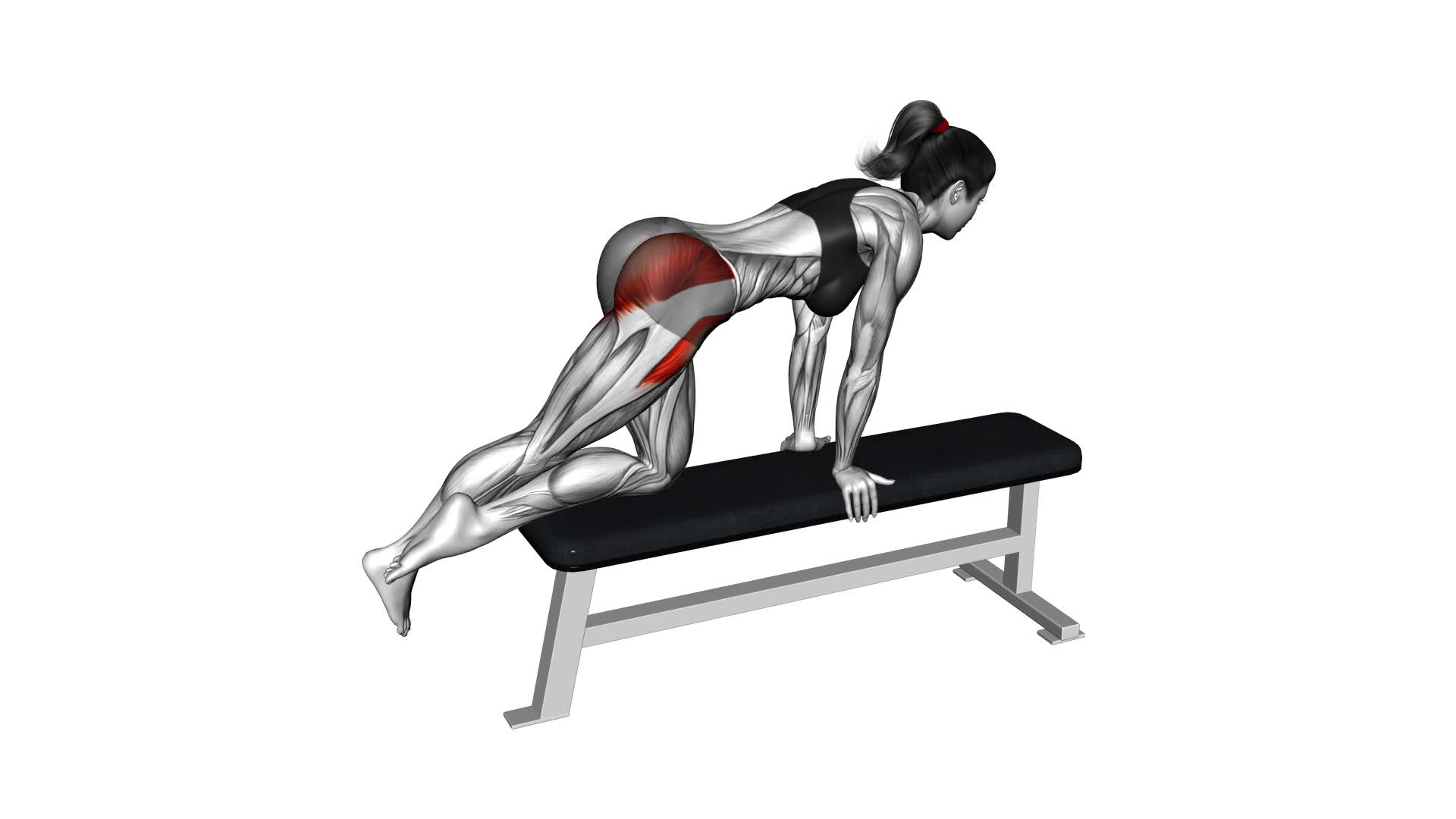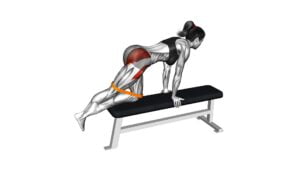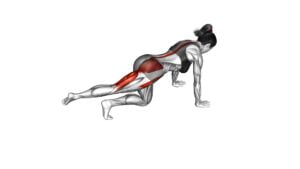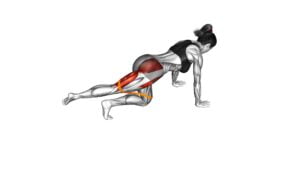Kneeling Leg Half Circle on Bench (Female) – Video Exercise Guide & Tips

Get ready to tone your legs with the Kneeling Leg Half Circle on Bench!
Watch This Exercise Video
In this video exercise guide, you'll learn the proper bench setup and step-by-step execution for this effective workout. Avoid common mistakes and maximize your results with helpful tips.
Plus, find modifications and variations to challenge yourself further.
Get ready to sculpt and strengthen with this targeted exercise.
Let's get started!
Key Takeaways
- Proper bench setup is crucial for effective and safe execution of the kneeling leg half circle exercise.
- Engaging the core and maintaining proper form is important for targeting the intended muscles and preventing injury.
- Slow and controlled movements, along with consistent practice, maximize the effectiveness of the exercise.
- Modifications and variations, such as increasing range of motion or adding resistance, can be used to challenge oneself and target specific muscle groups.
Proper Bench Setup for the Exercise
To properly set up the bench for the exercise, you'll need an adjustable bench and position it at a comfortable height. The proper bench setup is crucial for performing the kneeling leg half circle exercise effectively and safely. This exercise targets the glutes and hip muscles, and it's important to maintain proper form throughout to maximize its benefits.
Using a bench for the kneeling leg half circle exercise offers several advantages. Firstly, it provides stability and support, allowing you to focus on the movement without worrying about balance. Additionally, the bench allows for a greater range of motion, enabling deeper engagement of the targeted muscles. This can lead to increased strength and flexibility over time.
When setting up the bench, ensure that it's positioned at a height that allows your knees to be bent at a 90-degree angle and your feet to be flat on the ground. This will provide a stable base for the exercise. It's also important to adjust the bench to a comfortable angle, as this can affect the intensity of the exercise.
Now that you understand the importance of proper bench setup, let's move on to the step-by-step execution of the kneeling leg half circle exercise.
Step-By-Step Execution of the Kneeling Leg Half Circle
Now that you understand the importance of proper bench setup, how do you execute the kneeling leg half circle exercise step by step?
Start by kneeling down on the floor with your hands on the bench, positioned shoulder-width apart. Place one leg on the bench, keeping your knee bent at a 90-degree angle. Engage your core and lift your other leg off the ground, extending it straight behind you. This is your starting position.
Next, begin the exercise by moving your leg in a half circle motion towards the side of the bench. Keep your leg straight and try to maintain control throughout the movement. Slowly bring your leg back to the starting position and repeat the motion for the desired number of repetitions.
The kneeling leg half circle exercise offers several benefits. Firstly, it targets the glutes, hamstrings, and hip abductors, helping to strengthen and tone these muscle groups. Additionally, it improves stability and balance, as you need to engage your core and maintain control throughout the exercise.
Transitioning to the next section, it's important to be aware of common mistakes to avoid during the exercise.
Common Mistakes to Avoid During the Exercise
To avoid common mistakes during the kneeling leg half circle exercise, ensure proper form and positioning. Proper form is crucial for maximizing the benefits of this exercise and minimizing the risk of injury. Here are some common mistakes to avoid:
- Rounding the back: It's important to maintain a neutral spine throughout the exercise. Avoid rounding your back as this can put unnecessary strain on your lower back.
- Allowing the knee to collapse inward: Keep your knee in line with your ankle to maintain proper alignment and prevent strain on the knee joint. Engage your glutes and outer thigh muscles to help stabilize the knee.
- Moving too quickly: Slow and controlled movements are key to effectively engage the muscles and improve balance and stability. Rushing through the exercise can compromise your form and reduce the effectiveness of the exercise.
Proper form during the kneeling leg half circle exercise is essential for targeting the intended muscles and avoiding injury. Common muscle imbalances, such as weak glutes or tight hip flexors, can affect performance in this exercise. By maintaining proper form and addressing any muscle imbalances through targeted exercises and stretches, you can enhance your performance and prevent potential injuries.
Tips for Maximizing the Effectiveness of the Exercise
To optimize the effectiveness of the exercise, consistently perform the kneeling leg half circle with slow and controlled movements. This will ensure that you engage the targeted muscles properly and minimize the risk of injury.
Additionally, focus on your breathing techniques for better performance. Take deep breaths in through your nose and exhale fully through your mouth. This will provide your muscles with an adequate oxygen supply and help you maintain the necessary energy levels throughout the exercise.
Furthermore, it's crucial to emphasize the importance of core engagement during the exercise. Your core muscles play a vital role in stabilizing your body and maintaining proper form. To activate your core, imagine pulling your belly button towards your spine while performing the leg half circles. This will help you maintain balance and control, enhancing the effectiveness of the exercise.
Modifications and Variations to Challenge Yourself Further
To challenge yourself further, you can incorporate modifications and variations into your kneeling leg half circle on a bench exercise. By adding advanced progressions and exploring different equipment options, you can take this exercise to the next level.
Here are some modifications and variations to consider:
- Advanced Progressions:
- Increase the range of motion by extending your leg further during the half circle movement.
- Hold a dumbbell or kettlebell in your hand to add resistance and increase the intensity of the exercise.
- Perform the exercise on an unstable surface, such as a balance board or a Bosu ball, to engage your core and improve balance.
- Equipment Options:
- Use a resistance band around your thighs to create additional tension and target your glutes and hip muscles.
- Place a foam roller under your working leg to challenge your stability and activate your core muscles.
- If you don't have access to a bench, you can use a step or a sturdy chair as a substitute.
Incorporating these modifications and variations will help you continue challenging yourself and prevent plateaus in your fitness journey. Remember to always listen to your body and adjust the difficulty level according to your fitness level and goals.
Frequently Asked Questions
What Are the Benefits of the Kneeling Leg Half Circle Exercise?
The kneeling leg half circle exercise offers several benefits for your lower body. It targets your glutes, hamstrings, and hip flexors, helping to improve strength and stability in these muscles.
By performing variations of this exercise, such as using different bench heights or adding resistance, you can further challenge your muscles and enhance your overall fitness.
Incorporating the kneeling leg half circle into your workout routine can help you build a stronger lower body and improve your athletic performance.
Is This Exercise Suitable for Beginners?
Yes, this exercise is suitable for beginners.
If you have limited flexibility, there are modifications you can make. Start with a smaller range of motion and gradually increase as you become more comfortable.
To maintain proper form and technique, keep your core engaged and your back straight throughout the movement. It's also important to use controlled movements and avoid any jerking or swinging motions.
Remember to consult with a professional if you have any concerns or questions.
How Many Repetitions and Sets Should Be Performed for Optimal Results?
For optimal results, it's important to consider repetition and set recommendations. The number of repetitions and sets will depend on your fitness level and goals.
Typically, it's recommended to perform 8-12 repetitions per set for strength training exercises.
As for sets, beginners may start with 1-2 sets and gradually increase over time.
Advanced practitioners can add variations to challenge themselves, such as adding resistance or increasing the number of sets and repetitions.
Are There Any Alternative Equipment Options That Can Be Used Instead of a Bench?
If you don't have access to a bench, there are alternative equipment options you can use for the Kneeling Leg Half Circle exercise.
Instead of a bench, you can use a stability ball, a step, or even a sturdy chair. These options provide a similar level of stability and support.
Additionally, if you have knee or hip injuries, you can modify the exercise by using a cushion or towel under your kneeling leg for added comfort and support.
Can This Exercise Be Modified for Individuals With Knee or Hip Injuries?
If you have knee or hip injuries, it's important to modify exercises to prevent further damage. There are effective knee and hip rehabilitation exercises that can be done to help with your recovery.
These modifications may include reducing the range of motion or using alternative equipment. It's always best to consult with a professional, such as a physical therapist, who can provide personalized guidance and ensure you're performing the exercises correctly and safely.
Conclusion
In conclusion, the kneeling leg half circle on a bench is an effective exercise for targeting the leg muscles. By following proper bench setup and executing the exercise step-by-step, you can maximize its effectiveness.
Avoid common mistakes and consider modifications or variations to challenge yourself further. Remember to always prioritize proper form and technique to ensure the best results.
Incorporate this exercise into your routine for stronger and toned legs.

Author
Years ago, the spark of my life’s passion ignited in my mind the moment I stepped into the local gym for the first time. The inaugural bead of perspiration, the initial endeavor, the very first surge of endorphins, and a sense of pride that washed over me post-workout marked the beginning of my deep-seated interest in strength sports, fitness, and sports nutrition. This very curiosity blossomed rapidly into a profound fascination, propelling me to earn a Master’s degree in Physical Education from the Academy of Physical Education in Krakow, followed by a Sports Manager diploma from the Jagiellonian University. My journey of growth led me to gain more specialized qualifications, such as being a certified personal trainer with a focus on sports dietetics, a lifeguard, and an instructor for wellness and corrective gymnastics. Theoretical knowledge paired seamlessly with practical experience, reinforcing my belief that the transformation of individuals under my guidance was also a reflection of my personal growth. This belief holds true even today. Each day, I strive to push the boundaries and explore new realms. These realms gently elevate me to greater heights. The unique combination of passion for my field and the continuous quest for growth fuels my drive to break new ground.







